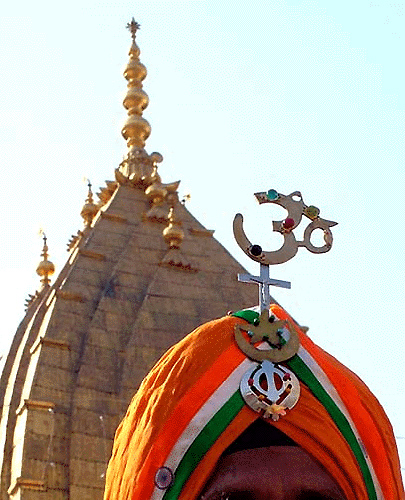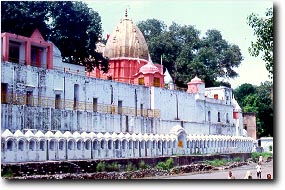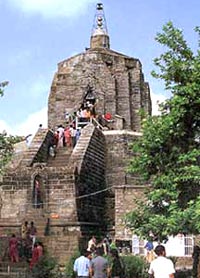The History of Jammu City as a Place of Temples
BY: YASAR M. BABA
 \
\
Photo by Jaipal Singh
Feb 15, KASHMIR, INDIA (KO) — The famous temples of Kashmiri Jammu.
Jammu city the winter capital of the State where the Maharaja used to reside during winter is 1,250 feet above the sea-level and is situated on a slope just above the right bank of the Tawi River. The city was not called the city of temples until Maharaja Gulab Singh the founder of the Dogra ruling family assumed the reins of the State of Jammu who apart from being a military strategist and commander was religious minded. In 1826, Maharaja Gulab Singh became the ruler of the State of Jammu; there was hardly any monumental building of any temple except that of Trikuta Bhagwati Vaishnodevji and Purmandal on the bank of the Holy Devak.
After assuming the reins of Government Maharaja Gulab Singh gave a special attention to the progress and development of Hindu religion and set up a large number of temples at various places. On 15th March 1846 the valley of Kashmir was also annexed after the treaty of Amritsar was signed; Kashmir with the Districts of Ladakh and Gilgit was ceded to Gulab Singh and he was recognized as an independent ruler both by the English and the Sikhs.
“In Consideration of the transfer made to him”, the Maharaja promised to pay to the British Government Seventy-five lacs of Nanak Shahi’ rupees, fifty Lacs to be paid on ratification of the Treaty, and twenty-five lacs on or before October 1, 1846 and in token of the supremacy of the British Government, was to present annually to the British Government one horse, twelve perfect shawl-goats of approved breed, six male and six female, and three pairs of Kashmiri shawls. Actually the Maharaja failed to take the possession of the valley from the then Sikh Governor, Sheikh Imam-ul-din, who defeated the Dogras in a battle at the foot of Shankaracharya Hill.
On hearing this Gulab Singh appealed to the British for help and force was dispatched under Sir Lawrence. And it was then the state came to be called as Jammu and Kashmir State, and Maharaja started to construct the temples in the valley also.
Maharaja established a treasury, called treasury of Shri Raghunathji, and gave personal donation of rupees five lacs. The Maharaja appointed his son Ranbir Singh as the Trustee of this endowment, who followed the footsteps of his illustrious father, Maharaja Ranbir Singh, who apart from being great patron of Art and learning was also religious; he started a campaign to spread a network of temples all over the state. Among which the most prominent temples are Shri. Raghunathji Temple complex (wherein he built thirteen stately Shrines around the main temple) and Shri Ranbireshwar at Jammu and the temple complex at Uttterbehni, Shri. Raghunath Temple at Maisuma and Shri. Ranbir Swami Temple at Feteh Kadal. During the time of Maharaja Ranbir Singh the number of temples increased in Jammu to such an extend that one can hardly go a hundred yards in any direction without coming across a temple. Thus the Jammu City came to be known as City of Temples.
The Maharaja also established Pathshalas for the propagation of Sanskrit. Five hundred scholars were admitted into the Pathshalas at Rughunath Temple, Ranbireshwar Temple and Shri Gadadhar Temple. Another five hundred scholars were admitted into the Pathshalas at Utterbehni. The Maharaja ordered that there shall be no restriction of caste with regard to the study of the Shastras in these Pathshalas. Maharaja Ranbir Singh invited highly learned Pandits from the different parts of India for the Sanskrit Library and Sanskrit Pathshalas attached to Raghunath Temple which includes vast treasure of Sanskrit Literature, having lot of Books and Manuscripts some of which are very rare. The Sanskrit scholars invited from other parts of India were: Pandit Varjalala from Jaipur, Rosmohan Bhattacharya from Bengal, Pandit Vyasa from Patiala, Devkrishna Jyotirvid from Banaras etc.
The works of Maharaja Ranbir Singh were also carried out by his Sons -- Maharaja Pratap Singh, Raja Ram Singh and Raja Amar Singh, who also used to give donations by which several new temples were set up. Gold ornaments and jewellery were used to be purchased for the decoration of the Murtis on the festive occasions Sadabrats were established at places of pilgrimage outside the state, such as Harudwar, Varanasi, Rameshwaram, Ayodhyaji, Vrindaban etc. Scholarships were given to the students from the state for pursuing higher studies in Sanskrit.
The process set by his predecessors was also followed by Maharaja Hari Singh who also contributed a lot towards strengthening the Raghunath treasury. He also threw open all the temples to the Harijans for Darshan and sanctioned scholarships for Harijan students in schools and colleges.
Some of the popularly known temples which were constructed, renovated and undertaken by the Maharajas were:
Shri Raghunath Temple at Sui Simbi. It was constructed by Maharaja Gulab Singh in the memory of his Guru Bawa Prem Dass.

Shri Raghunath Temple, Jammu. This is the biggest temple complex in Northern India. The main temple is of Bhagwan Ram. The Outer Parikarma consists of 14 temples dedicated to Vishnu, Ganesh, Bharat, Shatrugan, Narsingh, Krishan, Vrat, Vaman, Maha Lakshmi, Matsya Avatar, Kuram Avatar, Varat, Shiva and Lakshmi Narayan. The foundation stone of the temple was laid by Maharaja Gulab Singh in the year 1851 A.D. The inauguration of the temple was done by Maharaja Ranbir Singh in 1857 A.D.
Gadadhar Temple, Jammu with life size Murtis of Vishnu and Laxmi. It was built by Maharaja Ranbir Singh.
Gadadhar Temple, Utterbehni. This temple is dedicated to Lakshmi Naryan. Sarthaldevi (Kishtwar). The Murti is of Goddess Kali with 18 arms made of Black stone.

Ranbir Temple, Jammu. The foundation stone of the temple was laid by Maharaja Ranbir Singh in 1882 A.D. The Murtis were procured from Jaipur and the Lingams from Narmada River. The temple was inaugurated in 1940 and is known for the huge-sized Lingams.
Sharika Devi temple at Hari Patbat Srinagar, in which there is installed a beautiful image of black marble of the Goddess Sarika with eight arms, is in the fort on the crest of the Hari Parbat was constructed by Maharaja Gulab Singh. To reach the shrine from the foot of the hill, a flight of steps of stones was constructed by Maharaja Pratap Singh in 1895.

Purmandal Temple (left). The temple is dedicated to Lord Shiva and has been in existence for several hundred years.
Vasaknag Temple. Bhaderwah. This temple is dedicated to Vasudev. Khirbhawani (Srinagar). The shrine of Tulamulla dedicated to the Goddess Khirbhawani or Ragnya Devi is situated in the midst of a spring whose water changes colour occasionally. The temple was built by Maharaja Pratap singh and attracts several lakh devotees.

Shankaracharya Temple (left). Perched on a solid rock, about 1000’ft above the plain, this temple dedicated to Lord Shiva was built by King Gopadity, who ruled over Kashmir from 368 to 406 B.C.
Gadadhar Temple, Srinagar. This temple is situated on the bank of the Jehlum and is one of the most beautiful temples in the country. Ranbir Swami Temple and Raghunath temple. These temples dedicated to Bhagwan Ram are situated on the bank of the Jehlum and Maisuma respectively.
But for Kashmir Valley the record of the doings of the Dogra rulers, particularly by the Maharajas had been most disgraceful when looking into the actual living conditions of the people of Kashmir. It is the depth of the torment that has given strength to the people of Kashmir to protest against the autocratic rule. Because the Kashmiris were bought and sold like a commodity, the Muslims of Kashmir were deprived of all the pleasures of life and liberty under Dogra domination as compared to Jammu people. Even the British realized the stupidity of the sale of Kashmir but could not do anything because the possession of Kashmir was of a vital importance.
The author can be reached at yasarbaba786@yahoo.com
